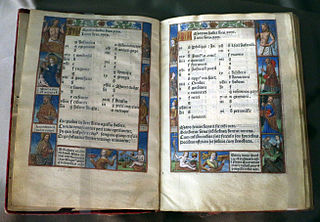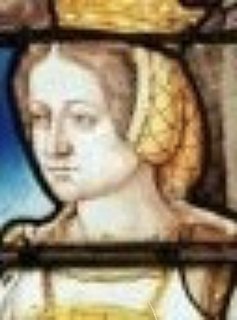Further reading
- (in French) Édouard Frère, De l'imprimerie et de la librairie à Rouen, dans les XVe et XVIe siècles, et de Martin Morin, célèbre imprimeur rouennais, Rouen, Le Brument, 1843.
Martin Morin was a French printer of incunables, active in Rouen between about 1490 and 1518. It has been suggested that he was born in or near Orbec around 1450, and died in Rouen around 1522. [1] He learned the trade in the Rhine region where he was sent by the Rouen family Lallemant together with Pierre Maufer, and then became a printer and bookseller in Rouen. His 1492 Breviarium Saresberiense or Breviarium Sarum, a breviary for Salisbury, is said to be "the first recorded liturgical book printed for the English market". [2]
The Incunabula Short Title Catalogue of the British Library lists 34 works. [3] Other works are listed in the Manuel du bibliographe normand: ou, Dictionnaire bibliographique ..., Volume 2 by Édouard Frère. [4]
Andrea Solari (1460–1524) was an Italian Renaissance painter of the Milanese school. He was initially named Andre del Gobbo, but more confusingly as Andrea del Bartolo a name shared with two other Italian painters, the 14th-century Siennese Andrea di Bartolo, and the 15th-century Florentine Andrea di Bartolo.
The Use of York was a variant of the Roman Rite practised in part of northern England, prior to the reign of Henry VIII. During Henry's reign the Use of York was suppressed in favour of the Sarum rite, followed by the Book of Common Prayer. "Use" denotes the special liturgical customs which prevailed in a particular diocese or group of dioceses; it is one of the medieval English Uses, together with the Use of Sarum.
The decade of the 1490s in art involved some significant events.
Christophe Gadbled was a mathematics professor at the University of Caen.

Jean Restout was a French painter. He was part of the Restout dynasty of painters, studying under his father Marguerin Restout. He is also known as Jean I Restout or Jean Restout the elder to distinguish him from his son Jean II Restout.

Édouard Frère was a French bookseller, archivist, biographer, and historian specialized in the Normandy area.

Jacques Restout was a French painter of the Restout dynasty and a Premonstratensian canon regular. Born in Caen, he was a student of Le Tellier and became prior of the abbaye de Moncets near Reims.

Eustache Restout was a French architect, engraver, painter and Premonstratensian canon regular, belonging to the artistic Restout dynasty. At his death he was sub-prior of abbaye Saint-Martin de Mondaye - he had produced the plans on which that monastery was rebuilt and painted several paintings for it. His students included his nephew Jean II Restout.

Guido de Monte Rochen or Guy de Montrocher was a French priest and jurist who was active around 1331. He is best known as the author of Manipulus curatorum, a handbook for parish priests, that was often copied, with some 180 complete or partial manuscripts surviving, and later reprinted throughout Europe in the next 200 years, with at least 119 printings, and sales which have been estimated to be three times those of Thomas Aquinas' Summa Theologica. It became obsolete only when the Council of Trent created the Roman Catechism in 1566.
Petrus Maufer, also known as Pierre Maufer, Pietro Maufer, or Petrus Maufer de Maliferis, was a 15th-century French printer of incunables, who learned the trade together with Martin Morin when the family Lallemant from Rouen sent them to the Rhine region to learn about book printing. Instead of returning to Rouen with Morin, he travelled to Italy and became one of the earliest known printers in Padua, Verona, Venice and Modena.

Philippe Pigouchet was a French printer and wood engraver who worked for and closely with Simon Vostre, a book keeper and publisher who planned the idea to create the fourth Book of Hours.
Marie-Madeleine Hachard née Hennebont was a French letter writer and abbess of the Ursuline order. She was one of the first members of the first Ursuline Convent in New Orleans in French Louisiana in 1727. Her letters home to her father in France have been preserved, published, and are valued as a source of historical documentation.

Stanisław Piotrowicz Kiszka was a noble, diplomat and military commander from the Grand Duchy of Lithuania. He became the progenitor of the prominent Kiszka family. He was sent on frequent diplomatic missions to the Grand Duchy of Moscow and Kingdom of Poland. He attempted to negotiate peace during the Muscovite–Lithuanian Wars and supported a closer union between Poland and Lithuania. During the Second Muscovite–Lithuanian War (1500–03), he successfully defended Smolensk and became Great Hetman until Konstanty Ostrogski escaped Russian captivity in 1507. Kiszka helped to subdue the Glinski rebellion in 1508. Shortly before his death, Kiszka also became Grand Marshal of Lithuania.
Jean Behourt, born in the first half of the 16th century in Rouen where he died in 1621, was a French grammarian and playwright.
Jean-Louis-Théodore Bachelet was a 19th-century French historian and musicologist.
François Le Prévost d'Exmes was an 18th-century French writer, playwright and literary critic.
Berthold Rembolt was a medieval printer.

Isabelle de Beauvau or Isabeau de Beauvau was a French noblewoman, of the Beauvau family, lady of Champigny and de la Roche-sur-Yon, countess of Vendôme by her marriage.